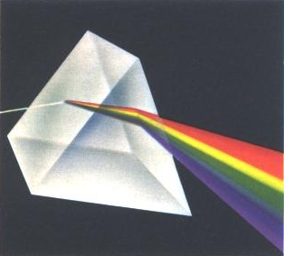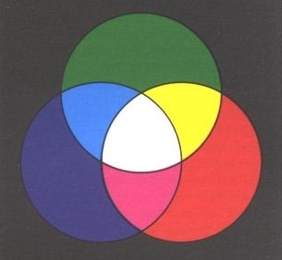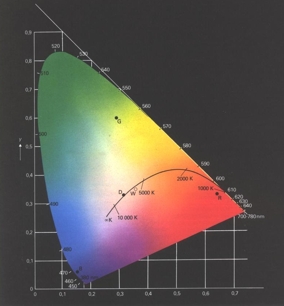|
 |
| |
| The
light that is visible in the human eye |
| includes
a wavelength area of electro- |
| magnetic
waves between ca. 770 nm (red) |
| and
ca. 390 nm (violet). In this area, that is |
| called
the light spectrum, the colours vary |
| dependent
on a certain wavelength. This |
| light
spectrum can be made visible when light |
| goes
through a prism (which breaks the light |
| with
a shorter wavelength more than the light |
| with
a longer wavelength). Each colour of the |
| spectrum
is a radiation of one single wave- |
| length
(monochromatic light). So, the (white) |
| light
that we perceive around us is a mixture |
| of
radiation of several wavelengths, each |
| with
an intensity of its own. And objects (that |
| do
not radiate themselves) have their 'own' |
| specific
colour because
they absorb the other |
| colours. |
| Indeed,
one can make white light by mixing |
| all
the colours of the spectrum with the so |
| called
Newtonian colour disc. This is a disc |
| which
sectors are painted with the spectral |
| colours
in certain proportions. When this disc |
| is
rotated quickly a white light impression is |
| produced.
This kind of mixing colours is |
| called:
additive colour mixing. |
| |
 |
| |
| By
adding or mixing three suitable light |
| colours,
the so-called ground colours or |
| primary
colours, in certain proportions any |
| colour
one wants can be produced. The most |
| suitable
colours are red, green and blue. |
| Two
colours added together that produce |
| white
are called complementary. For |
| example,
a yellow colour is produced by |
| adding
red and green. Therefore the |
| complementary
colours yellow and blue in |
| addition
produce white. |
| The
story is somewhat different in producing
or |
| mixing
paints or dyes or in the use of colours in |
| photography
or in printing, when subtractive
colour |
|
mixing is the case. Click
here for more information) |
| For
determining a colour exactly use is made |
| of
the so-called colour triangle. |
| |
 |
| |
| The
colour triangle is a presentation of |
| colours
in a plane in which the three additive |
| ground
colours form the angular points of a |
| triangle.
Any colour can be indicated by a |
| point
situated in this colour triangle. The |
| place
of this point with regard to the three |
| angular
points determines the proportion in |
| which
the ground colours occur in the |
| considered
colour. (W = the white point, x = |
| y
= 1/3; the colour points of the spectrum |
| colours
-of the monochromatic light- lay all |
| along
the curve 380 - 780 nm, the -straight- |
| line
between these points is called the purple |
| line.)
The saturation of the colours |
| diminishes
towards the white point W. |
| The
colour points R, G & B are the chosen |
| ground
colours in Europe for colour |
| television
and the very screen you're looking |
| at.
These capitals RGB do also make sense |
| in
most
languages, for R stands for 'Red' |
| (rouge,
rot, rood -rho-), G for 'Green' (grun, |
| groen
-gamma-)
and B for 'Blue' (bleu, blau, |
|
blauw -beta-). The
colours that are used in |
| programming
and
in web design are |
| therefore also usually
based
on the |
| RGB-palette
and 'translated' in specific |
| names,
in a decimal code or in a so called |
| hex
code, dependant on the programming |
| language
used. |
| |
| Click
here for the colour wheel tool where |
| you
can pick the colours of your choice and |
| see
immediately their hex codes. |
| |
| Click
here for a next page with a list of |
| colours
by their name, hex value, RGB value |
| and
sometimes their
Microsoft Access Code |
| number. |
| |